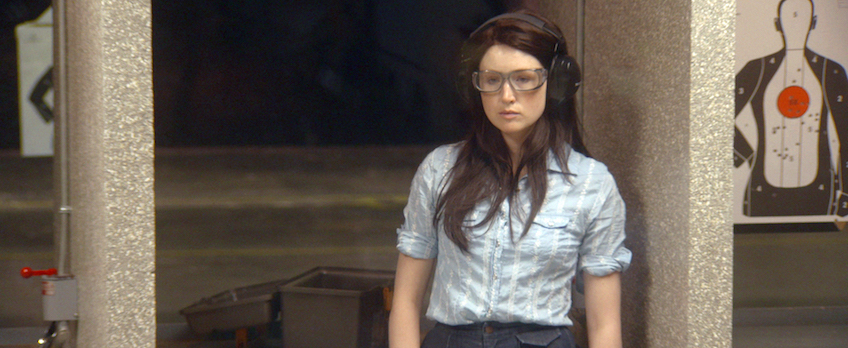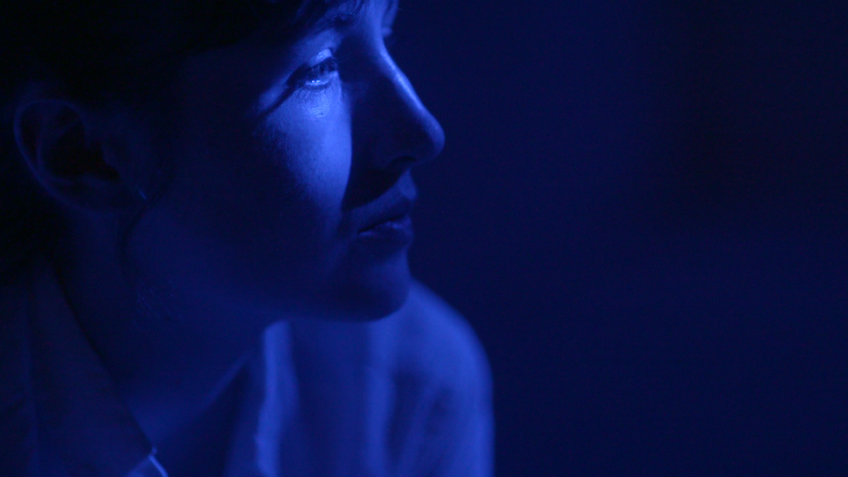Kate Plays Christine, Four Ways

During Critics Campus 2016 our critics took part in a live-editing workshop. Four of them reviewed Robert Greene’s latest feature, Kate Plays Christine, and then edited their drafts with Nick Feik, editor of The Monthly. Read their final reviews below – and don’t forget to check out all of our Critics Campus coverage.
Review by Jessica Ellicott
“If a performance of mine is called ‘subtle’ one more time, I think I might lose my mind,” says actress Kate Lyn Sheil, on the phone to her father near the beginning of Robert Greene’s Kate Plays Christine. She’s explaining why she’s looking forward to starring in a hyper-stylised 70s soap opera–esque film about the real-life televised suicide of reporter Christine Chubbuck in 1974. However the real (and, ironically, relatively subtle) performance is the one she’s giving on the phone. The conversation is staged, and the film she refers to doesn’t really exist: rather, it’s a film-within-a-film.
Kate Plays Christine experiments with Jacques Rivette’s famous maxim that every film is a documentary of its own making, instead asking whether this document of its own making should be made at all. Recalling Werner Herzog’s treatment of Timothy Treadwell’s death tape in Grizzly Man, the film fetishises the footage of Christine’s suicide by not showing it. Through interviews with Christine’s former colleagues, Kate learns that the tape of the fateful broadcast exists somewhere but remains inaccessible, various theories emerging about its whereabouts. Thus the tape functions as a sinister taunt, questioning the perverse impulse underlying the desire to watch such a thing.
The film-within-a-film is seemingly set up to fail. Kate struggles with the task of playing Christine – both physically and psychologically. She is transformed into a grotesque caricature of Christine, with a conspicuous wig, brown contact lenses and patchy fake tan, leading a man in a gun shop to mistake her for a mannequin. The production doesn’t go so well, either. There’s too little background information about Christine, causing Kate to become frustrated on set; at one point Kate says, with a sense of defeat, “I don’t know what to do, Robert. I don’t know what to do.”
One major effect of Kate Plays Christine is to provoke discussion about aspects of authenticity, performance and ethics in documentary, expanding on the themes of Greene’s previous film Actress (MIFF 15). It seems odd to evaluate the relative success of Kate Plays Christine, however, because to do so would entail determining the success of an intentional failure. By raising a mirror to itself, Kate Plays Christine seems designed to evade criticism. But is it possible to embrace a film that seems to reject itself?

Review by Doosie Morris
In 1974, Christine Chubbuck, a 29-year-old Florida TV journalist, shot herself in the head live on air. Four decades later, her death and its perplexing assertion of a violent type of female agency had all but faded into obscurity. Director Robert Greene resurrects the young reporter’s tale in his thought-provoking film Kate Plays Christine, which follows the research process of actor Kate Lyn Sheil as she prepares to star in a film about the troubled young anchor.
Kate travels to Florida to meet with locals and historians, and some of the few who knew Chubbuck. Stalked by Greene, she acquires a dark wig, contact lenses, a handgun and a spray tan as she attempts to transform herself into the self-possessed yet volatile reporter. But as the process gains momentum her true reason for doing so become increasingly unclear. Gradually tics and tells emerge. Greene is seen in frame offering direction for what is allegedly the separate dramatic biopic. After an on-set meltdown Kate remains fixated on the concerns of what is supposed to be a second-fiddle production. Something unusual is going on – or not going on.
An ominous hum lingers. For a while, the sombre mood is peppered with snippets of comic relief provided by Greene’s auxiliary cast and his teasing presentation of Kate’s often-awkward connection with them. Then as Kate becomes increasingly invested in the perceived responsibilities of her performance, her agitation and intense introspection start to permeate the film. Her moodiness and focus create a distance between filmmaker and subject, cleverly complementing one of the film’s conceits: sometimes the closer we try to get, the less clearly we can see. The tandem stories of the title characters – the two young women with ambitions to be seen and heard – intersect and overlap in surprising ways, as do some of Greene’s favourite themes: exhibitionism and performance and the reconciliation of identity.
On the day of her death, Chubbuck had scripted the news item as an attempted suicide, and requested that her final broadcast be recorded. A single copy of the tape reportedly exists, although this gruesome artifact remains unseen and unsought by the filmmakers. Yet from opening scene to final frame we are preparing for Kate’s re-enactment of Christine’s last moments. As Greene’s weird deconstructed film builds to this breaking point, some of the film’s curious duplicity falls away, finally surrendering to the impossibility of its own elaborate proposition.

Review by Andréas Giannopolous
Christine Chubbuck is less known than she should be – in Sarasota, Florida, in 1974, the news anchor took her own life on live television. In Robert Greene’s Kate Plays Christine, actress Kate Lyn Sheil is cast as Chubbuck in a planned biopic of the ill-fated newscaster. We follow her as she prepares for the role by researching Chubbuck’s life, visiting locations where Chubbuck lived and worked, and speaking to co-workers and locals. The kicker is that the film Kate is set to play Christine in exists only in the world of Kate Plays Christine: this unique concept opens the door to the film’s complex meta-narrative.
Since there is no end result to focus our attention on, the documented process itself becomes the end result. Greene portrays Chubbuck’s story and the questions it raises through Sheil actually asking those questions and attempting to understand what drove Chubbuck to cause her own death. It’s the classic actor’s question: “What’s my motivation?” Though everyone Kate asks has an explanation for what Christine did – depression, love-sickness, lack of friends, and lack of success in her field are all put forward – in the end, Kate can’t find a reason either, and almost doesn’t perform the suicide scene. The motivation that finally enables her to play it is perfectly tied to the nature of the film’s exercise in meta-cinema, so that, to the very end, Kate Plays Christine manages to sustain its rigour regarding the problem of human motives.
The result is something far more painful and touching than a straightforward biopic might be. As I watched Kate find similarities between Christine’s life and her own – their time in high school, their sexual experience (or lack thereof), comments they received on their looks – I came to realise that the film was asking me, too, to enter the mind of someone considering suicide, without constructing a neat causality for ultimately unsolvable actions.
It’s perhaps regrettable that the scenes from the make-believe biopic succumb to a quite laughable TV-movie banality. By deliberately making these scenes bad, Greene may be creating too weak an antagonist, thereby limiting the scope of his critique. Nonetheless, it could be argued that these scenes work within the fictional world that this film constructs. In any case, Kate Plays Christine deserves to gain a reputation as both an essential film on the idea of performance and as one of the cinema’s most delicate, honest, and painful handlings of suicide.

Review by Dominic Barlow
The aim of the movie biopic is to stress the importance of a historical figure. This is often achieved by turning their life into a simple narrative, but in Robert Greene’s investigative documentary Kate Plays Christine, this narrativisation is the last thing anyone wants to do. His lead actor, Kate Lyn Sheil, seethes with resentment as she fleshes out her performance as Florida newscaster Christine Chubbuck who, in 1974, shot herself on-air. Both Kate and her director shape the work around a gripping catch-22: how to preserve and honour a life without exploiting it?
To tackle this fraught endeavour, Greene bases some scenes on Christine’s life, and also documents Kate’s transformation for the role. She talks about the obsession and isolation that come with her craft, she pores through research, and she roams Christine’s hometown of Sarasota, Florida in denim cut-offs and a loose-fitting tee. These scenes contrast to later scenes where she slips into a wig and formal vintage dress, and, although she protests otherwise, the nuance of her performance emerges. While playing Christine is an act that’s based on supposition, the result is a clear and deep study of depression. She and Greene don’t dismantle the artifice of re-staged history so much as bolster it in unexpected ways.
The film examines how stories from the past are preserved and interpreted. This is a present-tense movie; it captures the people and places of Sarasota now. It’s only Kate who travels through time, back and forth to 1974. This is a smart move, particularly as Keegan DeWitt’s droning score transforms locales like Christine’s old workplace and home into morbid shrines, as though Kate might connect with a lingering ghost. These scenes are intended as solemn gestures, but they obscure the makers’ latent guilt rather than resolving it.
Kate makes noble inquiries in her interviews with those who experienced Christine’s tragedy. It’s clear from the quotes Greene selects that accounts of this suicide, and speculation on what caused it, can’t be separated from the interviewee’s personal definitions of despair. This gets to the heart of the film – Greene places his interviewees in order of increasing familiarity with Christine, hinting that a major reveal is coming. But the reveal is thwarted in a final speech that exemplifies his and Kate’s sense of powerlessness. We understand our own frustrations better than Christine’s, which makes Kate Plays Christine both fascinating and futile.
Want to know more about Christine Chubbuck? You can catch MIFF’s other film about Chubbuck’s life and death, Christine, on Fri 12 Aug 9pm at Comedy Theatre.
- Lifeline 13 11 14 www.lifeline.org.au
- Suicide Call Back Service 1300 659 467 www.suicidecallbackservice.org.au